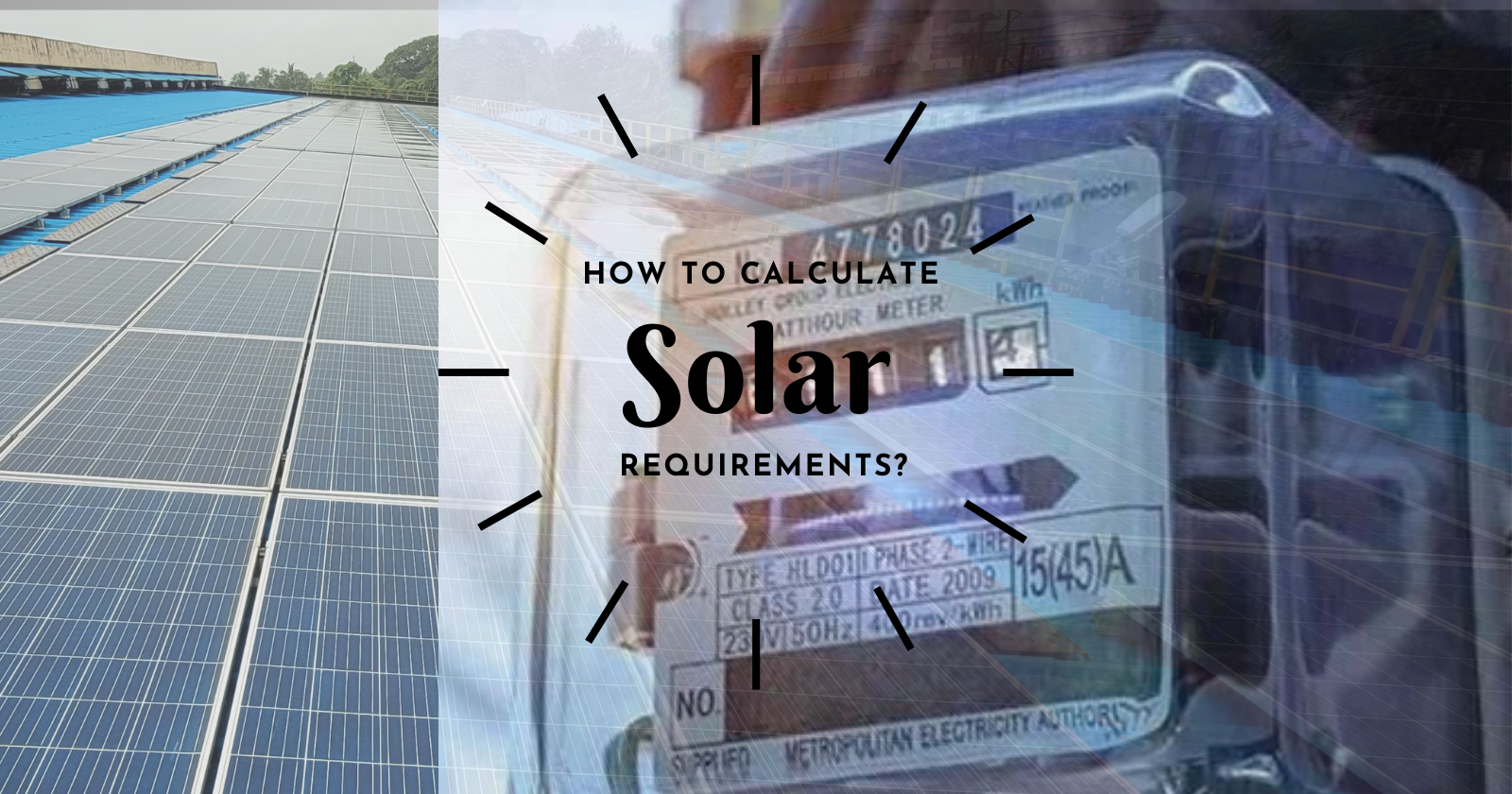How to Calculate Solar Panel Requirements from Electricity Bills.
 Healthy Solar
Healthy SolarTable of contents
- Step 1: Determine Your Average Monthly Electricity Usage
- Step 2: Calculate Daily Electricity Usage
- Step 3: Estimate Solar Panel
- Step 4: Calculate the Number of Panels Needed
- Step 5: Adjust for System Efficiency and Losses
- Step 6: Consider Future Needs Account for Growth
- Final Considerations
- Why People Should Know How to Calculate Solar Panels?
- Conclusion

With the rising costs of electricity and increasing environmental awareness, many homeowners are turning to solar power as a sustainable and cost-effective energy solution. If you're considering making the switch to solar energy, one of the first steps is determining how many solar panels you'll need to meet your electricity needs. Here's a comprehensive guide to help you calculate the solar panel requirements based on your electricity bills.
Step 1: Determine Your Average Monthly Electricity Usage
The starting point is to understand your average electricity consumption. Gather your electricity bills for the past 12 months to calculate your total annual usage in kilowatt-hours (kWh). Once you have this figure, divide it by 12 to find your average monthly electricity usage.
Example: If your total annual usage is 1000 kWh, your average monthly usage would be:
1000 / 12 = 83 kWh/month
Step 2: Calculate Daily Electricity Usage
To get a more granular understanding of your electricity needs, convert your monthly usage into daily usage. Divide your average monthly usage by 30, which is the approximate number of days in a month.
Example: With an average monthly usage of 83 kWh, your daily usage would be:
83𝑘𝑊ℎ 30 =2.7 𝑘𝑊ℎ/𝑑𝑎𝑦
Step 3: Estimate Solar Panel
Output Solar panels are rated by their power output in watts, but their actual energy production varies based on factors such as location, angle, and shading. On average, a solar panel produces between 250 and 400 watts per hour. To estimate the daily energy output, you need to consider the average peak sunlight hours in your location. This information is often available from local solar energy resources or online databases. For
instance, if your location receives 5 peak sunlight hours per day, a 300-watt solar panel would generate:
300 𝑤𝑎𝑡𝑡𝑠∗5 ℎ𝑜𝑢𝑟𝑠=1500 𝑊/ℎ =1.5𝑘𝑊ℎ/𝑑𝑎𝑦
Step 4: Calculate the Number of Panels Needed
Now, divide your average daily electricity usage by the daily output of a single solar panel to find out how many panels you need.
Example: With a daily usage of 1.5 kWh and a panel output of 1.5 kWh/day, the number of panels required would be:
2.7𝑘𝑊ℎ/𝑑𝑎𝑦 / 1.5 𝑘𝑊ℎ/𝑑𝑎𝑦 𝑝𝑒𝑟 𝑝𝑎𝑛𝑒𝑙 =2 panels
Step 5: Adjust for System Efficiency and Losses
It's important to account for system inefficiencies and potential losses, such as shading, dust on panels, and inverter inefficiencies. A typical practice is to add a 25% buffer to your initial calculation.
2∗1.25 = 3 𝑝𝑎𝑛𝑒𝑙𝑠
Step 6: Consider Future Needs Account for Growth
If you anticipate an increase in energy usage (new appliances, electric vehicles, etc.), you might want to size up your system.
Example: If you plan for a 10% increase in usage
2.7 kW × 1.1 = 2.6 kW
Final Considerations
Panel Wattage: The calculations assume a 300-watt panel, but panels come in various wattages. Adjust the calculations based on the specific panels you plan to use.
Sunlight Hours: Peak sunlight hours can vary significantly based on your geographic location. Ensure you use accurate data for your area.
System Losses: Consider factors such as shading, panel orientation, and efficiency of inverters and other system components.
Why People Should Know How to Calculate Solar Panels?
With the increasing focus on renewable energy and sustainability, solar power has emerged as a popular and viable option for many households. Understanding how to calculate the number of solar panels needed for your home can be immensely beneficial. Here are several reasons why common people should have this knowledge:
1. Cost Savings
One of the primary reasons people consider solar power is to save money on their electricity bills. By knowing how to calculate the number of solar panels needed, you can better estimate the initial investment and the potential savings over time. This knowledge enables you to make an informed decision about whether solar power is financially feasible for your household.
2. Energy Independence
Understanding how to calculate your solar panel requirements empowers you to take control of your energy production. By generating your own electricity, you can reduce your reliance on the grid and protect yourself from rising energy costs. This energy independence can provide peace of mind, especially in areas prone to power outages or where electricity prices are volatile.
3. Environmental Impact
Switching to solar energy helps reduce your carbon footprint and contributes to a more sustainable future. Knowing how many panels you need allows you to quantify the environmental benefits of your switch to solar power. This can be a motivating factor and a source of pride as you contribute to reducing greenhouse gas emissions and promoting clean energy.
4. Informed Decision-Making
When considering a solar installation, you will likely interact with solar providers and installers. Having a basic understanding of how to calculate your solar panel needs can help you have more informed discussions and evaluate the proposals you receive. This knowledge can help you identify any overestimation or underestimation by installers, ensuring you get a system that truly meets your needs.
5. Maximizing Efficiency
Understanding the calculations involved in determining solar panel requirements allows you to optimize the efficiency of your solar system. Factors such as panel wattage, peak sunlight hours, and system losses are crucial in designing an efficient system. With this knowledge, you can ensure that your system is designed to maximize energy production and efficiency.
6. Long-Term Planning
Investing in solar panels is a long-term commitment. Knowing how to calculate your requirements helps you plan for the future, considering factors like potential increases in energy consumption, expansions of your home, or future technological advancements. This foresight can help you design a system that remains effective and efficient for many years.
7. Educational Value
Learning how to calculate solar panel requirements can be an educational experience that broadens your understanding of renewable energy, electricity consumption, and environmental science. This knowledge can be shared with family and community members, promoting awareness and encouraging more people to consider renewable energy solutions.
Conclusion
Understanding how to calculate the number of solar panels needed for your home is a valuable skill that offers numerous benefits, from cost savings and energy independence to environmental impact and informed decision-making. By equipping yourself with this knowledge, you can make a well-informed choice about adopting solar power and contribute to a sustainable future. Whether you’re considering solar panels for financial, environmental, or educational reasons, this understanding can help you navigate the transition to renewable energy with confidence.
Subscribe to my newsletter
Read articles from Healthy Solar directly inside your inbox. Subscribe to the newsletter, and don't miss out.
Written by

Healthy Solar
Healthy Solar
Healthy Solar is a dynamic startup dedicated to advancing the renewable energy sector through innovative solar solutions. Despite being a new entrant, our team brings a fresh perspective and deep expertise in designing and installing efficient solar energy systems for a diverse range of applications. We focus on both commercial and residential markets, aiming to make solar energy accessible and effective for our clients. Our approach emphasizes a commitment to high-quality service and a strong dedication to understanding and meeting the unique needs of each project. At Healthy Solar, we combine modern technology with a proactive approach to anticipate challenges and deliver exceptional results. Our goal is to provide sustainable, reliable solar solutions that drive positive environmental impact and offer long-term value to our clients.